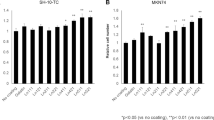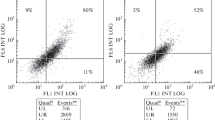Abstract
The invasive and metastatic characteristics of cloned cells derived from the K-1735 murine melanoma were investigated. Cell lines which are highly metastatic in mice were found to be invasivein vitro, and to show an enhanced attachment to, spreading on and migration toward laminin. As attachment, spreading and directional migration are thought to be receptor-mediated events, the binding of laminin to these cells was studied. Biotinylated laminin was used to evaluate receptor binding by fluorescence activated cell sorting (FACS) and this method was compared with that in which the binding of radioactive laminin is measured. Both studies revealed that metastatic K-1735 cells (a) have more receptors for laminin compared with non-metastatic cells and (b) exhibit a second population of low-affinity binding sites not present on the non-metastatic cells. The differences in receptor number and type may account for the greater interaction of metastatic cells with laminin and their invasive phenotype.
Similar content being viewed by others
References
Albini, A., Iwamoto, Y., Kleinman, H. K., Martin, G. R., Aaronson, S. A., Kozlowsky, J. M., andMcEwan, R. N., 1987, A rapidin vitro assay for quantitating the invasive potential of tumor cells.Cancer Research,47, 3239–3245.
Aumailley, M., Nurcombe, V., Edgar, D., Paulsson, M., andTimpl, R., 1987, The cellular interaction of laminin fragments. Cell adhesion correlates with two fragmentspecific high affinity binding sites.Journal of Biological Chemistry,262, 11532–11538.
Cheresh, D. A., Pierschbacher, M. D., Herzig, M. A., andMujoo, K., 1986, Disialogangliosides GD2 and GD3 are involved in the attachment of human melanoma and neuroblastoma cells to extracellular matrix proteins.Journal of Cell Biology,102, 688–696.
Codogna, P., Doyennette-Moyne, M. A., andAubery, M., 1987, Evidence for a dual mechanism of chick embryo fibroblast adhesion on fibronectin and laminin substrate.Experimental Cell Research,169, 478–489.
Del Rosso, M., Cappelletti, R., Viti, M., Vannucchi, S., andChiarugi, V., 1981, Binding of the basement membrane glycoprotein laminin to glycosaminoglycans.Biochemical Journal,199, 699–704.
Fidler, I. J., Gruys, E., Cifone, M. A., Barnes, Z., andBucana, C., 1981, Demonstration of multiple phenotypic diversity in a murine melanoma of recent origin.Journal of the National Cancer Institute,67, 947–956.
Fidler, I. J., andBalch, C. M., 1978, Tumor heterogeneity and the biology of cancer invasion and metastasis.Cancer Research,38, 2651–2660.
Goodman, S. L., Deutzmann, R., andVon der Mark, K., 1987, Two distinct cell-binding domains in laminin can independently promote non-neuronal cell adhesion and spreading.Journal of Cell Biology,105, 589–598.
Hujanen, E. S., andTerranova, V. P., 1985, Migration of tumor cells to organ-derived chemoattractants.Cancer Research,45, 3517–3521.
Jones, P. A., andDeclerck, Y. A., 1980, Destruction of extracellular matrices containing glycoproteins, elastin and collagen by metastatic human tumor cells.Cancer Research,40, 3222–3227.
Kennedy, D. W., Rohrbach, D. H., Martin, G. R., Momoi, T., andYamada, K. M., 1983, The adhesive glycoprotein laminin is an agglutinin.Journal of Cellular Physiology,114, 257–262.
Kleinman, H. K., McGarvey, M. L., Liotta, L. A., Gehron Robey, P., andMartin, G. R., 1982, Isolation and characterization of native type IV collagen from the EHS sarcoma.Biochemistry,21, 6188–6193.
Kleinman, H. K., McGarvey, M. L., Hassel, J. R., Star, V. L., Cannon, F., Laurie, G. W., andMartin, G. R., 1986, Basement membrane complexes with biological activity.Biochemistry,25, 312–318.
Kleinman, H. K., Luckenbill-Edds, L., Cannon, F., andSephel, G., 1987, Use of extracellular matrix components for cell culture.Analytical Biochemistry,166, 1–13.
Kleinman, H. K., Ogle, R. C., Cannon, F. B., Little, C. D., Sweenly, T. M., andLuckenbill-Edds, L., 1988, Laminin receptors for neurite formation.Proceedings of the National Academy of Science of the U.S.A.,85, 1282–1286.
Kramer, R. H., Bensch, K. K., andWong, J., 1986, Invasion of reconstituted basement membrane matrix by metastatic tumor cells.Cancer Research,46, 1980–1989.
Kripke, M. L., 1979, Speculations on the role of ultraviolet radiation in the development of malignant melanoma.Journal of the National Cancer Institute,63, 541–548.
Lacovara, J., Cramer, E. B., andQuingley, J. B., 1984, Fibronectin enhancement of directed migration of B16 melanona cells.Cancer Research,44, 1657–1663.
Lesot, H., Kuhn, K., andVon der Mark, K., 1985, Isolation of a laminin binding protein from muscle cell membrane.EMBO Journal,2, 861–865.
Levine, E., Birk, D. E., andRaska, K., 1984, Attachment and degradation of collagen substrata by adenovirus-transformed cells of varying tumorigenicity.Collagen and Related Research,4, 49–62.
Liotta, L. A., Thorgeirsson, U. P., andGarbisa, S., 1982, Role of collagenases in tumor cell invasion.Cancer Metastasis Reviews,1, 277–288.
Liotta, L., 1984, Tumor invasion and metastases: role of the basement membrane.American Journal of Pathology,117, 339–348.
Liotta, L. A., 1986, Tumor invasion and metastases. Role of the extracellular matrix. Rhoads Memorial Award Lecture.Cancer Research,46, 1–7.
Liotta, L. A., Mandler, R., Murano, G., Katz, D. A., Gordon, R. K., Chiang, P. K., andSchiffman, E., 1986, Tumor cell autocrine motility factor.Proceedings of the National Academy of Sciences of the U.S.A.,83, 3302–3306.
Lowry, O., Rosebrough, N., Farr, A., andRandall, R., 1951, Protein measurement with the folin phenol reagent.Journal of Biological Chemistry,193, 265–275.
Malinoff, H. K., andWicha, M. S., 1983, Isolation of a cell surface receptor protein from murine fibrosarcoma cells.Journal of Cell Biology,96, 1475–1479.
McCarthy, J. B., Palm, S. L., andFurcht, L. T., 1983, Migration by haptotaxis of a Schwann cell tumor line to the basement membrane glycoprotein laminin.Journal of Cell Biology,97, 772–779.
McCarthy, J. B., Basara, M. L., Palm, S. L., Sas, D. F., andFurcht, L. T., 1985, The role of cell adhesion proteins—laminin and fibronectin—in the movement of malignant and metastatic cells.Cancer Metastasis Reviews,4, 125–152.
Mensing, H., Albini, A., Krieg, T., Pontz, B. F., andMüller, P. K., 1984, Enhanced chemotaxis of tumor-derived and virus-transformed cells to fibronectin and fibroblast-conditioned medium.International Journal of Cancer,33, 43–48.
Netland, P. A., andZetter, B. R., 1986, Melanoma cell adhesion to defined extracellular matrix components.Biochemical and Biophysical Research Communications,139, 515–522.
Nicolson, G. L., Irimura, T., Gonzales, R., andRuoslahti, E., 1981, The role of fibronectin in adhesion of metastatic melanoma cells to endothelial cells and their basal lamina.Experimental Cell Research,135, 461–465.
Nicolson, G. L., 1982, Cancer metastasis: organ colonization and the cell surface properties of malignant cells.Biochimica et Biophysica Acta,695, 113–176.
Rao, C. N., Barsky, S. H., Terranova, V. P., andLiotta, L. A., 1983, Isolation of a tumor cell laminin receptor.Biochemical and Biophysical Research Communications,111, 804–808.
Reich, R., Thompson, E., Iwamoto, Y., Martin, G. R., Deason, J. R., Fuller, G. C., andMiskin, R., 1988, Inhibition of plasminogen activator, serine proteases and collagenase IV prevents the invasion of basement membrane by metastatic cells.Cancer Research,48, 3307–3312.
Roberts, D. D., Rao, C. N., Magnani, J. L., Spitalnik, S. L., Liotta, L. A., andGinnsburg, V., 1985, Laminin binds specifically to sulphated glycolipids.Proceedings of the National Academy of Sciences of the U.S.A.,82, 1306–1310.
Ruoslahti, E., Hayman, E. G., Pierschbacher, M., andEngvall, E., 1982, Fibronectin: purification, immunochemical properties and biological activities. In L. W. Cunningham and P. W. Frederiksen, Eds.,Methods in Enzymology (Academic Press, New York, London, Paris), Volume 82, pp. 803–831.
Scatchard, G., 1949, The attractions of proteins for small molecules and ions.Annals of the New York Academy of Sciences,51, 660–672.
Talmadge, J. E., andFidler, I. J., 1982, Enhanced metastatic potential of tumor cells harvested from spontaneous metastases of heterogenous murine tumors.Journal of the National Cancer Institute,69, 975–980.
Terranova, V. P., Liotta, L. A., Russo, R. G., andMartin, G., 1982, Role of laminin in the attachment and metastasis of murine tumor cells.Cancer Research,42, 2265–2269.
Terranova, V. P., Rao, C. N., Kalebic, T., Margulies, T. M., andLiotta, L. A., 1983, Laminin receptors on human breast carcinoma cells.Proceedings of the National Academy of Sciences of the U.S.A.,80, 444–448.
Terranova, V. P., Hujanen, E. S., andMartin, G. M., 1986, Basement membranes and the invasive activity of metastatic tumor cells.Journal of the National Cancer Institute,77, 311–316.
Timpl, R., Rohde, H., Robey, P. G., Rennard, S. I., Foidart, J. M., andMartin, G. R., 1979, Laminin—a glycoprotein from basement membrane.Journal of Biological Chemistry,254, 9933–9937.
Timpl, R., 1982, Antibodies to collagens and procollagens.Methodsin Enzymology,82, 472–498.
Turpeeniniemi-Hujanen, T., Thorgeirsson, U. P., Rao, C. N., andLiotta, L. A., 1986, Laminin increases the release of type IV collagenase from malignant cells.Journal of Biological Chemistry,261, 1883–1889.
Varani, J., andWard, P. A., 1982, Tumor cell chemotaxis.The Biological Basis of Metastasis, edited by I. Hart and L. A. Liotta, (The Hague: Martinus Nijhoff), pp. 99–112.
Vlodavsky, I., andGospodarowicz, D., 1981, Respective roles of laminin and fibronectin in adhesion of human carcinoma and sarcoma cells.Nature (London),289, 304–306.
Volk, T., Geiger, B., andRaz, A., 1984, Motility and adhesive properties of high- and low-metastatic murine neoplastic cells.Cancer Research,44, 811–824.
Author information
Authors and Affiliations
Rights and permissions
About this article
Cite this article
Albini, A., Aukerman, S.L., Ogle, R.C. et al. Thein vitro invasiveness and interactions with laminin of K-1735 melanoma cells. Evidence for different laminin-binding affinities in high and low metastatic variants. Clin Exp Metast 7, 437–451 (1989). https://doi.org/10.1007/BF01753664
Received:
Accepted:
Issue Date:
DOI: https://doi.org/10.1007/BF01753664




